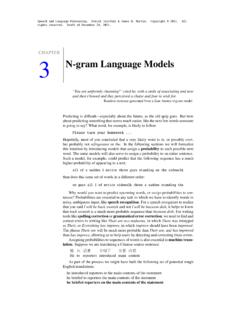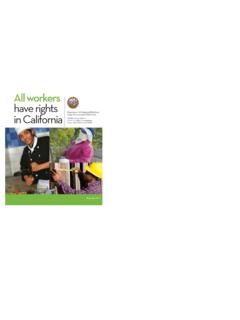Transcription of KNOW YOUR RIGHTS
1 know your RIGHTS MATERIALS 1) Enough handouts for each student (attached to lesson). 2) Re-useable white board, markers, eraser if you want one (provided in the PICC). 3) Bingo supplies (attached at the end of the lesson). TAKEAWAYS o Students will have a basic sense of the Constitutional origins of their RIGHTS . o Students will know key RIGHTS and the amendments from which they come. QUICK INTRO (Time Check: 1 minute) Tell the class: your names, that you re law students from Stanford Law School, and you re there to teach a StreetLaw class.
2 O Remind the students about StreetLaw rules: don t talk about the specifics of your case, respect your classmates and your teachers. ICEBREAKER: Got RIGHTS ? (Time Check: 5-10 minutes) Go around the class and have each student name a right guaranteed by the Constitution, and an example of what that right means. Have the teachers start it off to give examples for the students ( the right to bear arms, it means the gov t can t take the people s guns away keep it simple, broad strokes). If you have time, ask the students to say whether or not they think this right is important, or why.
3 Thank the class for participating. know your RIGHTS 2 ACTIVITY 1: Bill Of RIGHTS Basics (Time Check: 25 minutes) Introduction Tell the students that you know they ve all heard of the Bill of RIGHTS . Explain what the Bill of RIGHTS is (First 10 amendments or changes to the US Constitution which enumerate specific RIGHTS of all people in this country). Most of these RIGHTS are pretty famous the RIGHTS to free speech, bear arms, due process these are all fairly well-known. Hand out the Bill of RIGHTS handout (attached at the end of the lesson).
4 Note that these are some of the most famous words ever written, but acknowledge that it isn t necessarily clear what they mean. Tell students that today, we re going to take a closer look at a few of these RIGHTS , where they come from, and what, exactly, they mean. Super-Quick History Ask if anyone can tell you where one can find the Bill of RIGHTS . Where s it written? (The Constitution) Who wrote it? (James Madison) Why did we need a Bill of RIGHTS ? (After the Constitution was ratified in 1787, people thought that there weren t enough individual liberties included specifically, so they added these first ten Amendments to the Constitution, and ratified them in 1791).
5 Deconstructing The Bill Divide the class into three groups. Tell them that each group is going to get three Amendments. They should read through the Amendments very carefully, figure out what they think they mean, and then, in ten minutes, each group will explain their three Amendments to the class. Teachers will join each group to help out, so no pressure! Tell the class that since there are ten Amendments, we ll do the first one together as a big group. Write the First Amendment up on the board.
6 Break it up into its five major RIGHTS . Parse it carefully for the class, so that you manage to get freedom of speech, freedom of religion, freedom of the press, the right to assemble, and the right to petition out of it. Give a brief example of each. Divide up the Amendments amongst the groups, giving one group the Second, Fifth, and Ninth, one group the Third, Fourth, and Tenth, and one group the Sixth, Seventh, and Eighth (or whatever other division seems equitable to you). Help the students parse out their Amendments.
7 After ten minutes or so, go through the Bill of RIGHTS (in order) and have the groups explain their RIGHTS to each other. Note: Most students will get tripped up on the actual language of the Bill of RIGHTS ; focus on the individual RIGHTS outlined in each without getting bogged down in the legalese. If you can, work in past lessons search and seizure, Miranda, even Three Strikes (which can be discussed in an Eighth Amendment context). know your RIGHTS 3 ACTIVITY 2: Bill Of RIGHTS BINGO! (Time Check: 25 minutes) Hand out the Bingo boards to students.
8 Explain that now that we have a basic sense of what each Amendment means, we re going to play a game. Ask if everyone is familiar with the game of BINGO you have a board, and the goal is to cross off a row of squares, whether horizontal, vertical, or diagonal. This game is similar in the first round, we re going to call off basic RIGHTS and students are to cross off the squares if they have a square with the Amendment that right comes from. So, if I call off Freedom of the Press! and you have a square with the First Amendment, you can cross it off.
9 First one to get a whole row crossed off yells BINGO! and is the WINNER! In the Second Round, we re going to make it a lot harder. We re not going to just name RIGHTS any more we re going to give the class situations. Each player has to decide what right is involved in that situation, and then cross off the proper Amendment. When someone wins BINGO, they ll have to explain why they picked the RIGHTS they did. Note: Try to get through the first round quickly it s just there to build confidence.
10 The meat and potatoes of this game is in the second round! If the class seems comfortable with the Bill of RIGHTS (or has seen this lesson before), feel free to skip to the second round. Teacher Resource BINGO Calling Sheet Round 1 BINGO Callers Sheet (keep it RANDOM) ROUND ONE 1st Amendment Freedom of Speech Freedom of the Press Freedom of Religion Right to Assemble Right to Petition 2nd Amendment Right to a militia Right to keep and bear arms 3rd Amendment Protection from the Quartering of Troops 4th Amendment Protection from Unreasonable Search and Seizure Warrant Requirement 5th Amendment Due Process Double Jeopardy Right Against Self-Incrimination Eminent Domain 6th Amendment Trial by Jury Speedy Trial Public Trial Right to Confront Accusers Right











